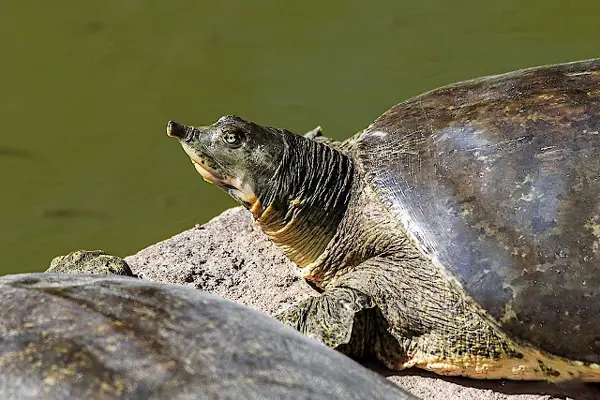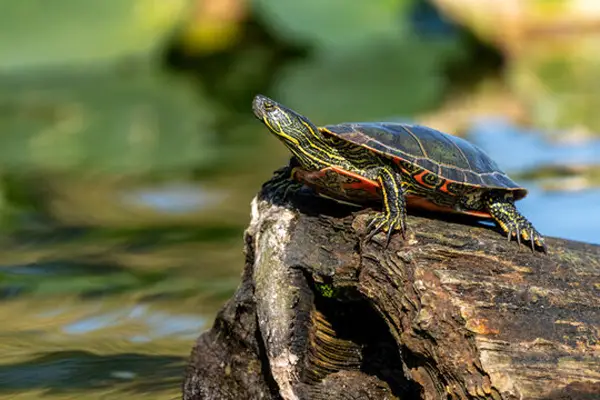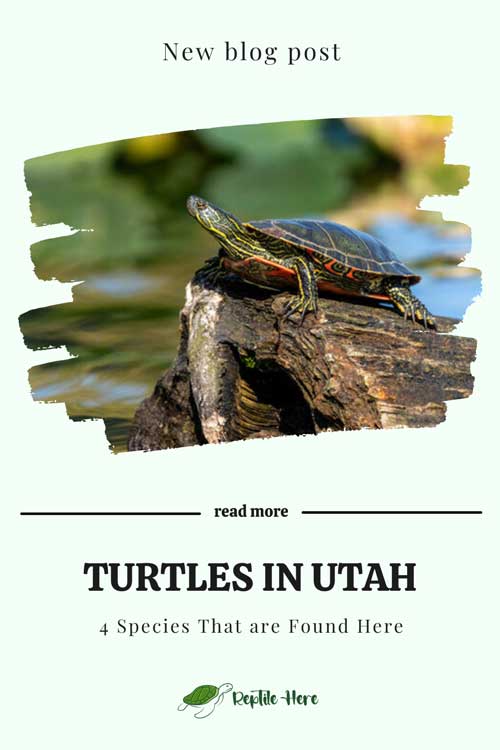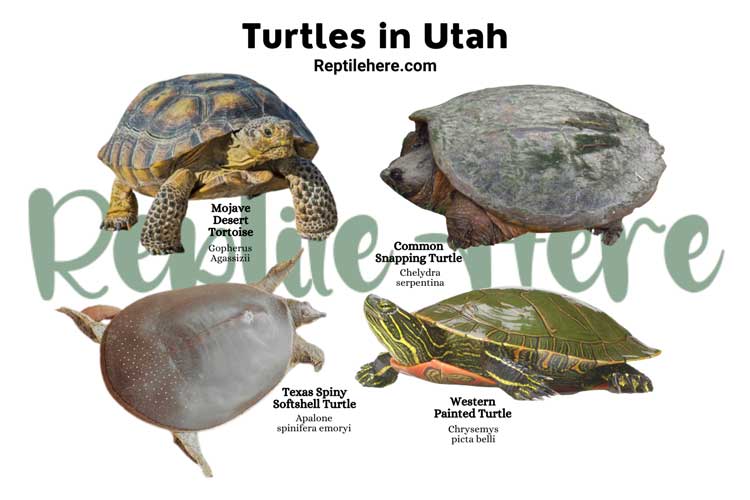Turtles in Utah – 4 Species That are Found Here
Utah is home to 4 species of turtles including common snapping turtles, western painted turtles, Texas spiny softshell turtles, and the desert tortoise.
The desert tortoise is the ONLY Utah’s truly native tortoise and inhabits the Mojave Desert all the way up to southern Utah.
Chances are high that the other 3 species are not native to Utah.
Below, we take you through each species of turtles inhabiting Utah and key facts about them like physical appearance, how long they live, where they live, what they eat, and more.
4 Types Of Turtles in Utah
Contents
1. Common Snapping Turtle

- Scientific name: Chelydra serpentina
- Common name: Snapping Turtle
- Family: Chelydridae
- Size: 8 to 18 1/2 inches
- Lifespan: 30 to 50 years or more
- Conservation status: Least Concern
Common snapping turtles are widespread throughout Utah. An average adult is pretty large and has a shell length of 18½ inches long. It is, no doubt, the biggest guy in Utah!
This species has a chunky head, a long tail, and large webbed feet. The shell color is black or olive and has no distinct pattern.
These Utah snapping turtles are known for their powerful jaws—they’re so strong that these turtles eat other turtles!
You’ll find them in waterbodies with muddy bottoms in Utah. Examples include marshes, ponds, lakes, rivers, and even shallow streams
They generally prefer waters with aquatic vegetation in plenty and foods such as fish, frogs, birds, etc.
These Utah turtles generally show docile behavior but can get quite aggressive if taken out of water. The best way to calm it is to take it back to the waters, where it feels safe.
2. Texas Spiny Softshell Turtle

- Scientific name: Apalone spinifera emoryi
- Common name: Spiny Softshell Turtle
- Family: Trionychidae
- Size: 5 to 9 inches (males), 12 to 20 inches (females)
- Lifespan: 30 to 70 years
- Conservation status: Least Concern
The Texas Spiny softshell turtle is a medium-to-large freshwater species that live in Utah’s lakes, streams, and rivers with muddy or sandy bottoms and little or no vegetation.
Female spiny softshell turtles are usually larger than males. And unlike other turtles, this species has a flexible, leather-like carapace that’s extremely rounded and flattened.
The shell color can be olive grey or yellow-brown. Just like other softshell turtles, this species also has a snorkel-like snout.
The young ones feature well-defined round spots that are easily visible on the shell (though these spots become invisible as they transition to adulthood).
Spiny softshell turtles in Utah tend to eat anything they find in the waters including crayfish, insects, small fish, and so on. They hunt by burying themselves in the mud or sand while keeping their head uncovered to grab food as it swims by.
These turtles are also able to breathe underwater by taking in oxygen through their throat skin. This is a useful adaptation given that they don’t spend a lot of time out of water.
Other adaptations of these Utah turtles include webbed feed, long claws, and extremely flat shells that enable them to quickly swim away from predators and burry in the muddy bottom of the waters they reside in.
Also read: Turtles in California
3. Western Painted Turtle

- Scientific name: Chrysemys picta belli
- Common name: Westland Painted Turtle
- Family: Emydidae
- Size: 4 to 10 inches
- Lifespan: 30 to 40 years
- Conservation status: Vulnerable
The Western painted turtle is a subspecies of painted turtle and is also found in Utah waterbodies.
This turtle is identified by an oval-shaped carapace that lacks a ridge in the middle. The carapace is usually dark olive or black in color.
The lower side of the shell is usually red, with multiple dark markings in the center. And the skin itself is covered with yellow stripes.
Westland painted turtles of Utah are aquatic and their webbed feet help propel them in the waters.
The most common habitats for this turtle in Utah include slow-moving rivers, shallow streams, and lakes. They choose these areas because they can easily find food.
Given that they’re omnivorous, they feed on aquatic vegetation as well as meat from insects, snails, shrimps, tadpoles, and earthworms.
Their hatchlings are more carnivorous to help take in more proteins for building muscle.
4. Mojave Desert Tortoise

- Scientific name: Gopherus Agassizii
- Common name: Mojave Desert tortoise, Desert tortoise
- Family: Testudinidae
- Size: 10 to 15 inches
- Lifespan: 60 to 80 years
- Conservation status: Threatened
The Desert tortoise is one of the native species of Utah. It prefers living in the semi-arid climates in the Southern parts of Utah and is capable of withstanding intense heat and little rain.
A desert tortoise is defined by a large domed shell ranging from brown to green, while its scutes have light patches. It stays relatively inactive for the most part of a year, during which it digs caves and burrows
Unfortunately, this keystone species is threatened, mostly due to habitat loss, and is under protection by Utah authorities.
The desert tortoise in Utah is herbivorous and feeds on wildflowers and grass. During the summer months, it has been observed feeding on cacti and other succulents.
It’s also worth noting that the desert species of California is labeled as an “indicator species.” This means it is used to show the health of the ecosystem by observing its population health.
Unfortunately, the Desert tortoise population is on a downward trend throughout its habitat. This has been attributed to issues like mining, expansion, natural predation, and destruction of their burrows by off-road vehicles.
Related: Turtles in Kentucky
Conclusion
Although Utah is the 13 largest state in the US, it is home to only 4 species. And out of these 4 turtles, only one is truly native to the state, the Mojave tortoise.
The other turtles found in Utah include common snapping turtles, western painted turtles, and Texas spiny softshell turtles.
We hope that this guide has provided you with the info you need to know about turtles of Utah and key facts like habitat, diet, lifespan, looks, and conservation status.


